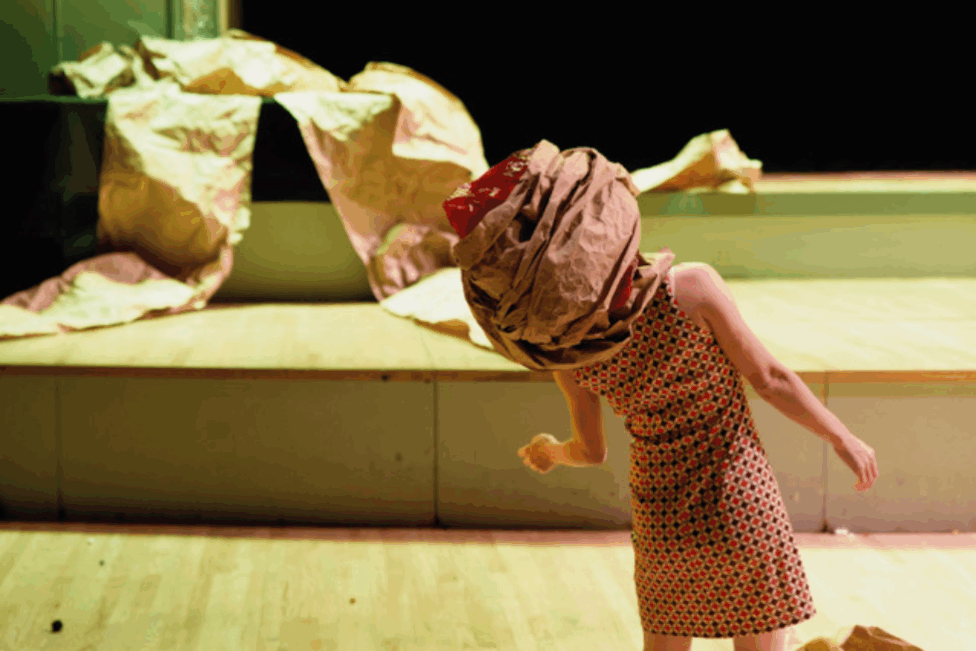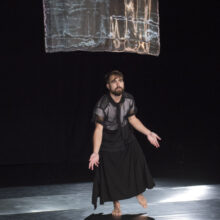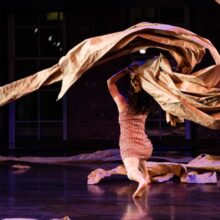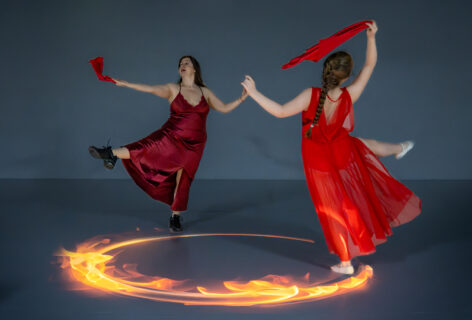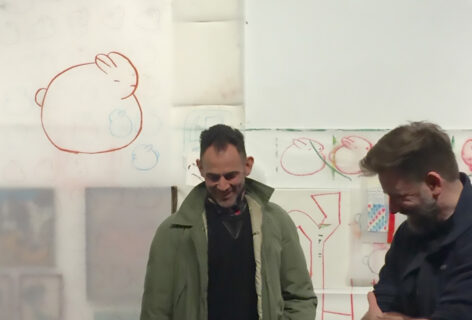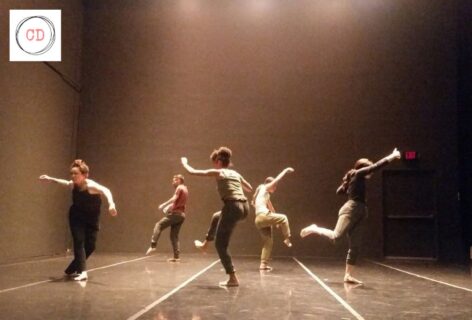We have admired Nami Yamamoto and Julian Barnett over the years, and see a shared quality of earnestness in their works. As we witness their commitment to body, process, and ideas, they can be funny and almost absurd in performance. And it’s often a product of their genuine and sincere engagement with physical tasks and actions. The two have cultural ties to Japan, which allow them to connect through a shared sense of liminality in their experiences of place. In this conversation, we learn that their multifaceted practice enables them to feel more at ease inhabiting multiple identities, as it fulfills more than one need. They describe using the vastness of improvisation as a coping mechanism, exploring its complexities and connotations, and its reactive power to reflect the “now.” We are so grateful to peek into this intimate conversation by these two generous and curious dance practitioners in our field.
-Takahiro Yamamoto, CC Co-Editor & Liz Westbrook, CC Intern
This article has been edited for the purpose of publication.
Julian Barnett
It’s lovely. There are these invisible overlaps between you and I both at NYU, but also a bit in Japan. Although I’ve never spent any time in Matsuyama City or Shikoku island where you have an intimate relationship with. I’m mostly connected to Tokyo, where I was born.
I’m curious about improvisation because it’s a broad term that I use to facilitate both my personal and artistic life, but also in teaching, parenting, a little bit of everything. When did that get introduced? When did that become a facet? From what I see in these movement studies that you do, there seems to be something about an embodiment of a moment. I always perceive it a little bit politically because it always seems like a response to the shit in the world or the beauty in the world. You know, not to be too binary, but the shit and the beauty of the world. I’m curious if improvisation is a word that you gravitate towards, or is it more performance? Not that we need to label it, but I’m just curious about improvisation. For the evening-length work like Headless Wolf, a lot of that material is generated from improvisation and scores, or…?
Nami Yamamoto
Some of them are heavily set, I would say. I was figuring out how to really detail meticulously, thinking about the timing and everything. I think in my work, timing and detail are so important to me. I mean, we have to set for the puppet because that’s already unpredictable.
JB
It’s so beautiful, this sort of extension of the figure of the body with puppetry. That work is stunning. I love it.
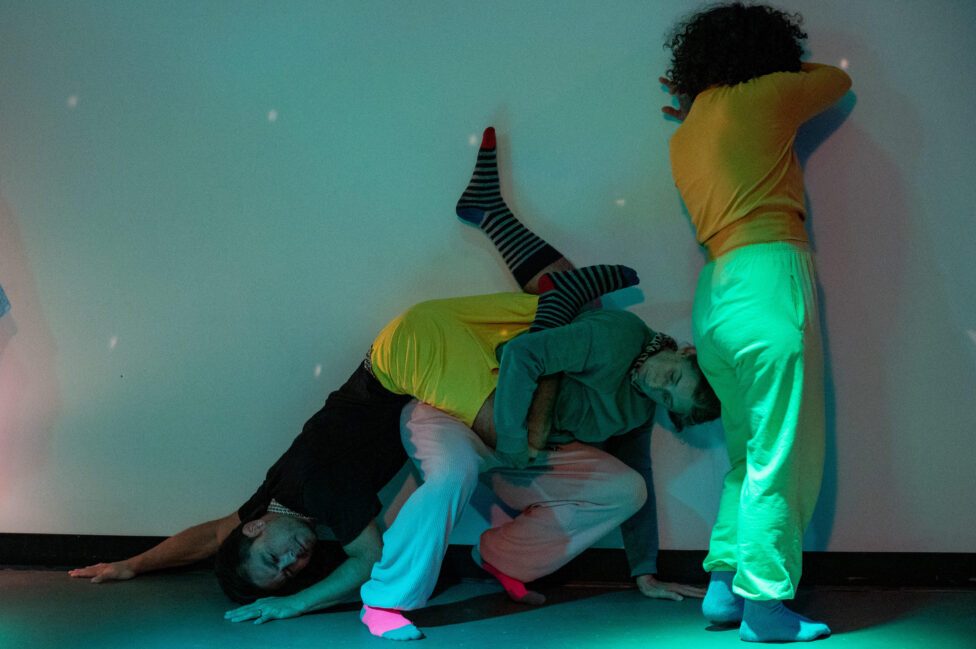
NY
When we showed the work-in-progress of Headless Wolf at Judson, I just had a few rehearsals with Johanna S Meyer and Mina Nishimura. Somebody said, Oh, you look like you opened a new door. For the showing, I didn’t set too much and decided not to worry too much about it. We had a clear score and improvised with it. Then, it opened up some doors. Coincidence and accident are always there when we create. There was something happening. So it feels like improvisation came in without my expectation. I didn’t expect something to happen, but it just happened and I took it,
JB
Yeah, like setting the conditions for it to emerge or something. I’m sort of fixated on the idea of improvisation because there’s something about the value of it, or having to articulate the value of it. Particularly in an academic context, often, but also sometimes in making “set material”, what the value of improvisation can be. I love to be in kind of these micro-discourses, but my brain always kind of zooms out. I always get macro. So I think about what is the value of improvisation in 2025, 2026, socially, politically. Maybe this is me projecting a little bit, but there seems to be an external force, which I can pinpoint. I do think it’s a political force to some extent, a cultural force, where they say, “no, the value of improvisation is not there anymore.” People are questioning it, or people don’t get it, or people reject it. I just feel like I want to keep fighting. It’s a hill that I want to die on.
NY
I’ve seen your work, and you also work with other people. I just saw you in Julie Mayo’s piece. In my eyes, it looks like there is a very concrete score there, but I feel like it’s heavily improvised at the moment. “Improvise” for me means what I’m seeing might be different from one day to the next, but underneath of it, something is always there to embrace it. When that comes out, it’s a little bit different each time. That’s what I saw and what I kind of guessed. Way back when you and Jeanine Durning were working on the idea of non-stopping, the value is there, but it’s almost like living in the moment. Yesterday, today, tomorrow, it’s different. When you said improvisation, I thought there are so many improvisations everywhere. When you put in the performance, sometimes different values come out.
JB
Different expectations, maybe?
NY
Sometimes people think, “Okay, I’m gonna do this, and this part is improv.” But it’s not just improv. It has a weight to it. I am not sure exactly how to say it, but I’m not gonna set it, just go with the idea.
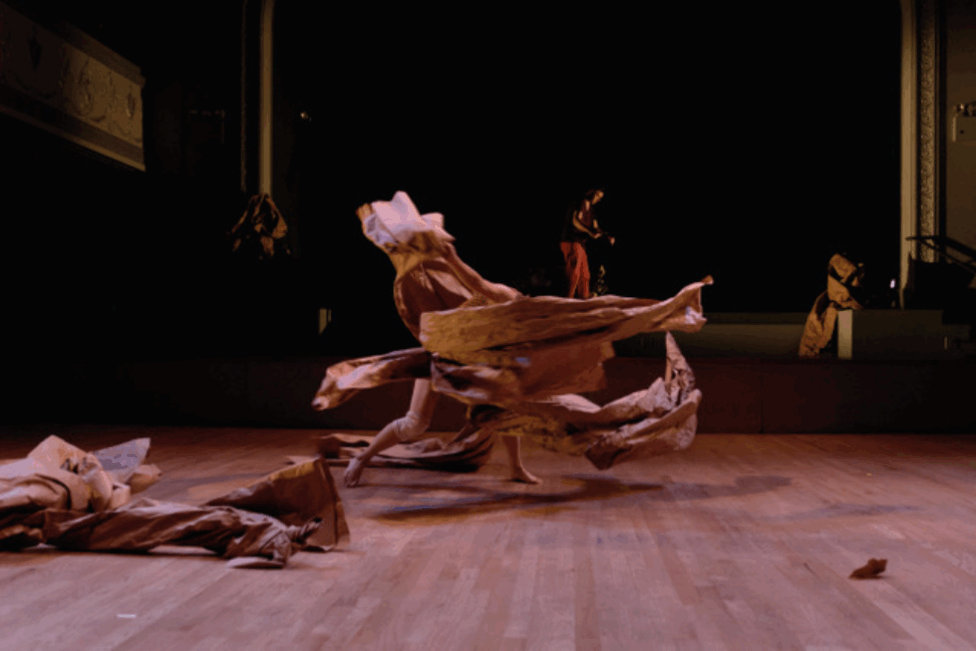
JB
I’m using improvisation as a pretty wide terminology. And all the people that you referenced, Julie Mayo, Jeanine Durning, Abigail Levine, and even Wally Cardona, which was one of my first experiences of working with improvisation in performance, they all never use the word improvisation. They don’t. Maybe there is rejection of that terminology first and foremost. It’s been a long time with Wally, but Wally, from the beginning, was always at practice. Practice. Let’s just do practice. With Jeanine, it was a very particular thing. Non-stopping. And all its complexities and layers. Julie is a little more of a naming of a particular score, which can be absurd or often sort of an emotional name. But what does it produce? What do these ideas around improvisation, whether it’s practice, sensation or state-oriented, produce? Even in my work, I don’t use the word improvisation. I think it’s a way to distill it down sometimes when we can float off in many different ways. But I’m attracted by what it produces, not only externally for an audience, of course, but I am interested in sensation from the performer, but then also how that’s reciprocal, to some extent, with the audience. So it does change frequently. Even working with Kota Yamazaki, in my sort of experience of working with Butoh, it’s very much quote and quote, “improvisation.” But that word never enters the conversation. The word is almost too rigid to some extent. It feels very much state-oriented, sensation-based. I was at a period where I was working with Kota and Jeanine, kind of simultaneously, both people who I adore. And I don’t want to speak for Jeanine, but there’s something about not wanting it to be sensation based. It was something about the practicality of it, like the doing, the effort, the non-stopping. Just keep doing it. And then meaning and affect, these are my words, will emerge. What does it produce, whether that’s chaos or intensity or mundanity?
NY
Just hearing that… you have so many hats. Dancing for other people, that’s already a lot, but you do — you teach, you make your own work, you parent. It’s so many hats. Sometimes I get very confused. I mean, most of the time I’m very confused. I feel like I have to focus on one thing because other things can be too much. Especially when you are working with other people, I get confused. So I have to do my own thing to just clear up my head. How do you resolve in your mind and the body as you extend yourself.
JB
I feel immensely grateful that I have been able to be in these vectors. I enjoy being influenced while always having a steady desire for my own ideas. That’s the outlet for my work. I feel very lucky that I can still dance. I’m not 20, but yet I’m here still dancing. I kind of embrace the multifaceted thing, too. I’m half Japanese, so I have this sort of confused identity to begin with. I’ve never been fully Japanese. I’ve never been fully American. What does that even fucking mean? So I’ve always been in this sort of hybrid, in-between state. A lot of my life I’ve been asked, where are you from? There’s like an opacity, an opaqueness to me. I remember Kota kind of talking about this: the mystery or something you can’t quite identify. I used to really hate that. So, I started break dancing. That’s all I do, and then I did ballet and other forms. Okay, well, improvisation, oh, my God, this is a whole other world that enabled me to be comfortable in the unknown. So one thing really led to another, and rather than staying in one particular lane. Not to sound super simple or cliche, but I’ve been very lucky to be in these multifaceted spaces. It is about sustainability too, I think. When I deep dived into Butoh, I was like, Oh, my God, this is what I’m going to be doing for the rest of my life, and I love this so much. And yet, somehow the deviation began, but yet the Butoh is still there. It’s not like things get shed necessarily. The body is an archive, so I’m always kind of building on top of it. I don’t know if I’m resolved. I’m not an anxious person. Thankfully I’ve always been somewhat Zen. Maybe, maybe that is from my okaasan, my mom. But there’s no resolve. I’m not resolved. Ha.
NY
You are grateful for being influenced. That is amazing. That’s beautiful. And sometimes that’s hard. I want to take note of it and write about it. I should think about it. Grateful to be influenced. That’s amazing.
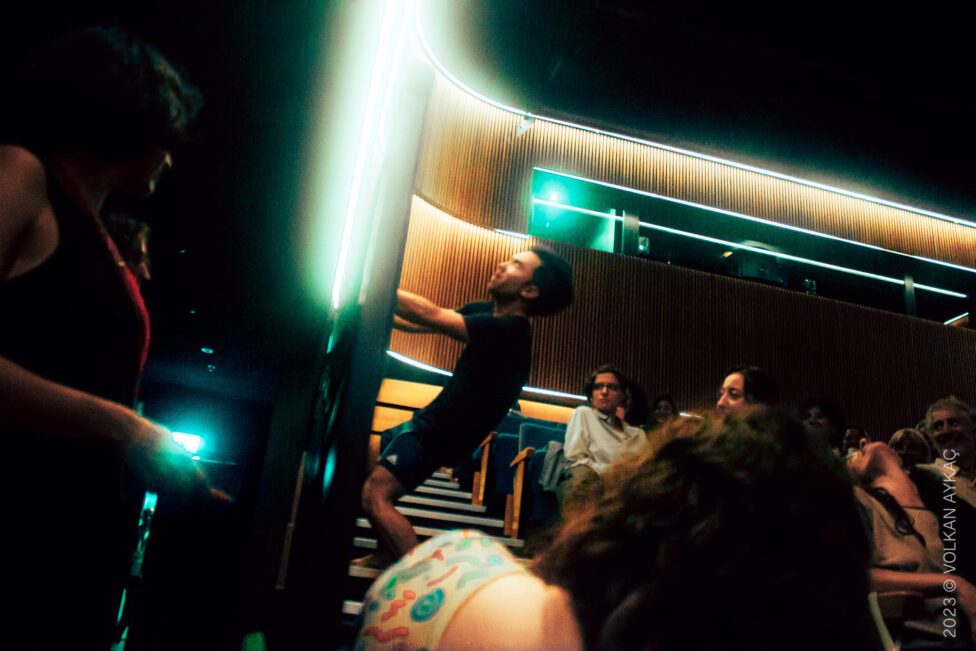
JB
Can you talk a little bit about these outside movement studies? You post them on social media sometimes, do you? It’s not necessarily a formulated question. But I’m wondering if there are any prompts for these studies or these videos? I’m looking at all of these beautiful three-minute studies.
NY
That was mostly from the COVID pandemic time. I needed to do something. So I started going outside and took a video. It’s proof that I’m still alive. We lived in the Lower East Side, so almost every day we went to the East River Park, trying to get air and see the water. That just continued for a while. Missing Takumi, and Memories, were projects with the students from Ehime University where I’m from. I still know the people in the university. When I go home, I often visit them and see their rehearsal. I was worried about them. They were in their senior year, and they couldn’t do much. So, I asked them if they could send me a clip of their dancing, then maybe we can do something together. They sent me clips, and I put them together as a video project.
JB
Amazing. Do you still make these movement studies?
NY
I just do short videos and post on Instagram, but I have done a video project for a year or two. I tried to upload it every month, every two months, to just make something, put it together. It’s just for myself anyway. I was thinking about editing and timing. It’s low tech, but at the same time, I can learn something. It’s all a study just for myself.
JB
I like the idea of affirmation, these affirming snippets or these affirming little moments that insist that, yes we still move or we’re still here. Like I mentioned, I’ve looked up to you for so, so long. You bring such a magical quirkiness, but also quirkiness that gets offset by a real depth, like a real resonant emotion. Not just simplify it, but there’s something emotional. I wrote down something you had said before, something about the use of the breasts in Trooper’s Brothers, which I find really fascinating. Maybe there’s a sort of connection to that question around improvisation, “what does it produce?” I don’t know if this is too personal, but what are some of the personal things that you bring into your work?
NY
It’s just what was just happening at the moment of my life, what that gives to me.
JB
Can I ask, what was happening in your life?
NY
For Headless Wolf, that was basically about my dad getting sick, and my daughter growing up. At one moment of their life they looked kind of physically similar. One was trying to walk. The other one was losing the capability to walk. When you look at the moment, it looks the same, but where they are heading are quite different. That fascinated me. At the same time, it’s hard to deal with it. It was my escape. I’m coping with the situation. I start observing what’s happening, especially around his care. Some people, his caregiver, I can see, wanted to help, but he was new to caring for elderly people, his body was so tense. You start looking at how they’re producing their body energy of feeling like they want to help, but they can’t. I saw their intention there even though they were not doing anything. Other things like, his doctor bowed to my mom, as if he was saying something like, there is nothing we can do anymore. The way he bowed to her was very sincere. He is a doctor who everybody looks up to, right? It was one little gesture, but had so much meaning to me: the physical distance between my mom and his doctor, how sincerely he bowed to her, said a lot.
JB
There’s a subtext there now when I go back and see that piece. That’s a pretty powerful subtext.
NY
People don’t have to know, but I do. I have to know.
JB
yeah, exactly, yeah.
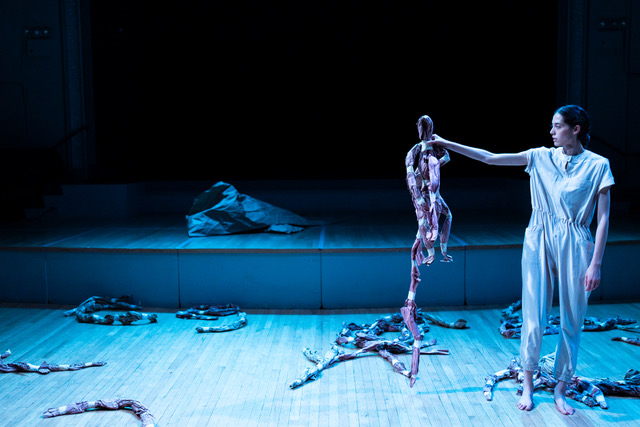
NY
So that was the connection of that. Coming from a different country, I speak Japanese and English. I don’t even know my Japanese is actually good anymore. But when you think about the language of dance, you can actually express something deeper. We all know that. This is my tool to embrace that I’m here. It’s like trying to find that deeper part of me to put out there.
JB
That’s so powerful. Sometimes I think that intention is not enough. You can have good intentions, or you can have the intention to help, or the intention to whatever it might be. But sometimes it needs more information, or it needs more consideration. And then also this idea of fragility of care, and how it can produce an immediate intimacy between people that you don’t necessarily know. Certainly not an equivalent to real life, mortality, let’s say, to art and performance, but there’s some parallel there. You create these intimacies with an audience because of the care of the performance or what’s at stake in a performance, and that can create an intimacy.
NY
When someone is going to see a show, you see, for example, a performer moving their hair. I don’t have to understand the meaning or context. But I start feeling something. I can’t put a word on it, but I was like, “Oh, this is, like, getting into my body.” The part I love about dance and movement is that kind of richness in both body and movement. It’s your body that is moving and producing something. It’s there, and as soon as you move, it disappears. The moment only lives in my mind. That’s really fascinating to me: something about appearing and disappearing. It’s just like life. I don’t know how long I have a life, but in the life span, you see different people. If you’re born a different time, you don’t see that person. Reflecting back to what you said about being “grateful,” I think I start feeling grateful about being here at this moment, whatever’s happening. I’m living in this moment, not 100 years ago.

